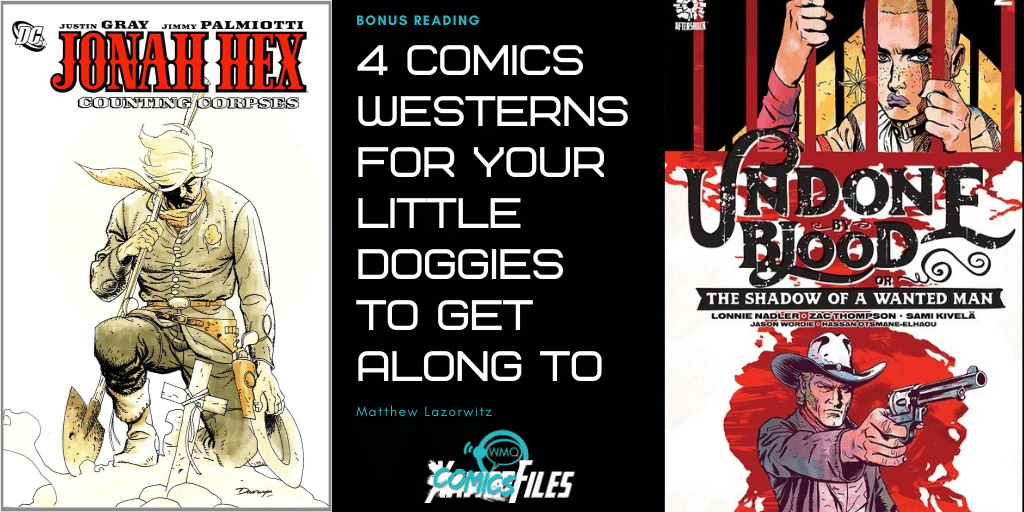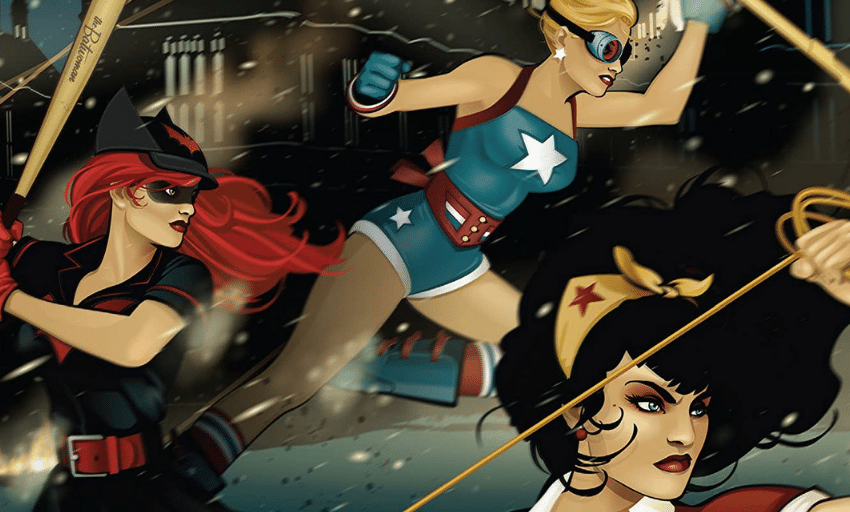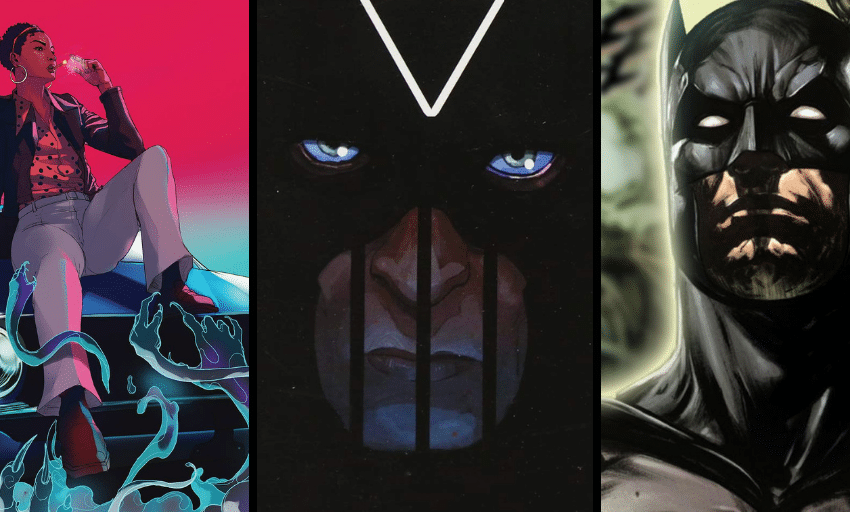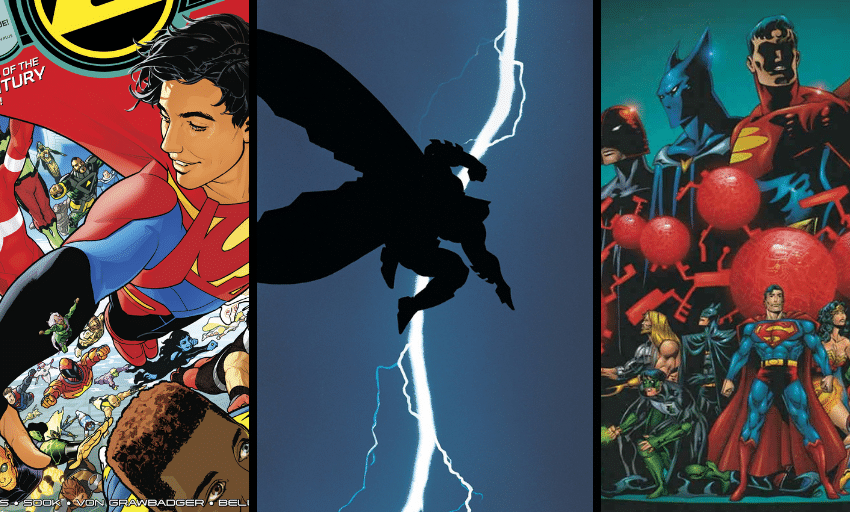
High noon in a desert town. Two men face off, hands on the butts of their holstered revolvers. [Grote’s note: Heh heh, butts.] A blur of motion, a crack of gunfire, and one (or both) falls. This scene is a hallmark of the American Western, a genre that was popular in comics throughout the 1950s and ’60s, and has waxed and waned in popularity over the years.
While the crime genre has reawakened in the past decade, the Western has, with a few notable exceptions, remained quieter. That’s not to say there aren’t some great Western comics out there. This week saw the release of Pulp, an Image graphic novel from the team of Ed Brubaker and Sean Phillips that mixes the Western and crime genres. And so, since I’ve spent plenty of time writing about crime comics, I thought this week would be a good time to focus on four modern Western comics.
Jonah Hex

Comics’ most recognizable Western character is probably DC’s Jonah Hex. On top of being the only Big Two Western character to headline his own ongoing series in the last 20 years, he’s starred in his own movie (not great, but it happened), appeared multiple times on The CW’s DC’s Legends of Tomorrow, and made a great appearance in “Justice League Unlimited,” where, when asked how he immediately identified Justice League members as time travellers, he says, “I’ve led an interestin’ life.” And he certainly has.
Created by John Albano and Tony DeZuniga in 1972’s All-Star Western #10, Hex is very much an anti-hero, pre-dating characters like Wolverine and Punisher by two years. His longevity is probably based both on that cold, calculating nature, something that would allow him to fit in better than more traditional Western heroes; and his striking visual: the horrible scars on his face and the Confederate uniform he continued to wear long after the Civil War ended. Even though creators have gone to pains over the years to point out that Hex wears the uniform not because of a belief in the Confederacy but as a way to distance himself from those around him, I would not be surprised if that element of the character changes with any future appearance.
A bounty hunter, Hex travels through the West bringing in criminals dead or alive. OK, usually dead. He is not a cheap thug but a tracker, a hunter and far more clever than many of his opponents give him credit for. Despite having no compunctions about killing a man (or woman) in cold blood, Hex has a personal code that would often lead him to defend the innocent, even if he did it as gruffly as possible.
Hex headlined All-Star Western into the time it was retitled Weird Western Tales, and only left that title when he was granted his own series, which lasted nearly seven years into the early ’80s, long after most Western titles were canceled. In the mid-’80s he appeared in Hex, a title where he was sent into a Mad Max-esque dystopian future. In the ’90s, he appeared in a trio of miniseries at DC’s mature readers imprint, Vertigo, written by award-winning novelist Joe R. Lansdale (who would also write his one appearance on Batman: The Animated Series, the episode “Showdown, where Hex battles Ra’s al Ghul). In the ’00s into the ’10s,writers Jimmy Palmiotti and Justin Gray wrote a celebrated run on a new Jonah Hex ongoing, drawn by some of comics’ best artists, including Darwyn Cooke, J.H. Williams III and Hex co-creator DeZuniga, and even brought the character into the New 52, with a three-year run on a new volume of All-Star Western.
Blaze of Glory/Apache Skies

If I get the chance to write about a John Ostrander comic, I am going to take it. Ostrander is no stranger to Westerns. He wrote The Kents for DC, the story of Superman’s adopted family in the Old West, and his creator-owned character Grimjack is a Western-type anti-hero in a sci-fi setting. But for Marvel, he took that same grizzled aesthetic from Grimjack and used it to tell the last story of Marvel’s Western heroes in 2000’s Blaze of Glory: The Last Ride of the Western Heroes and 2002’s Apache Skies, both drawn by Leonardo Manco.
The town of Wonderment, Montana, populated by freed slaves, has come under attack by a group of Ku Klux Klan riders. Former Western hero Reno Jones, a member of duo known as the Gunhawks and a resident of Wonderment, goes out to gather a team of heroes to fight back. It’s a pretty standard Western plot, inspired by the classic film “The Magnificent Seven,” and draws in characters like the Rawhide Kid, the Two-Gun Kid, Red Wolf and the Outlaw Kid. Ostrander plays with expectations, not making the bad guys simply Klan members causing chaos but adding the elements of greed that systemic racism often is a symptom or cause of. The story ends in exactly what the title hints at, a massive battle that leaves few survivors. While the first miniseries is an ensemble piece, its sequel, “Apache Skies,” focuses on two characters, Two-Gun Kid and a new character. It’s an equally good series, and an often forgotten early entry in Marvel’s mature-readers MAX line.
Ostrander’s scripts add nuance to a lot of these somewhat one-dimensional Western heroes, but if you’re familiar with his work, he also knows how to play to his artists’ strengths. And these series move from strength to strength for Manco. The art is highly detailed, and so gritty you can feel the dust of the trails. Colorist Mariana Manco adds to that grit in the first series, while Leonardo Manco colors himself in a more painterly style in the second, giving the books distinct feels, while still being very much connected.
East of West

The genre mash-up of science fiction and Westerns goes back for decades, tracing its roots to Star Wars. But rarely has there been a better, or stranger, combination than current X-mastermind Jonathan Hickman and artist Nick Dragotta’s Image series East of West, which combines not just Western and sci-fi but alternate history and biblical prophecy to create a vivid tapestry of a world in the throes of apocalypse (the concept, not the big blue mutant).
Set in the near future of an alternate timeline where the American Civil War left the country fragmented into seven nations, “East of West” follows a collection of characters from each of the nations as they attempt to bring about, or stop, the prophesied apocalypse. Each nation has a different flavor. The Union is industrial. The Confederacy feels like the old South. The Kingdom is an Afro-futurist nation. The Endless Nation of Native American tribes blends science and magic. The People’s Republic of America, founded by Chinese exiles, is a military power. The Republic of Texas has a similar vibe as the Confederacy, but with a Texan flare. And in the center sits Armistice, the unaligned area where The Chosen, those who serve the Word and the Horsemen of the Apocalypse, conspire and plan both the downfall of the world and each other.
Hickman plans big, and over 45 issues, he creates a massive cast of characters, some noble, most far from it. The closest character to a main protagonist is Death, the Horseman who forsook his oath and fellow horsemen when he fell in love with Xiaolian, the daughter of Mao V, the ruler of the People’s Republic. The story opens 10 years after Death, who dresses like a Western gunslinger all in white — a pale rider if you will — killed his fellow horsemen for killing his bride, when the horsemen are reborn and begin the final push to the apocalypse. The series burns slowly, seeding hints in early issues that won’t pay off for years, in that way that Hickman loves to do.
The series blends Western tropes and design with some seriously crazy science fiction. Dragotta goes to town on the designs in this book, giving a unique style to not just each character but each nation. He draws monsters, war machines, and people of all manner and shape. The series wrapped up at the end of 2019, and the final trade was released last week.
Undone by Blood, or the Shadow of a Wanted Man

So we’re ending this week moving from a series that blends Western and science fiction to one that blends Western with the ’70s revenge genre. Lonnie Nadler and Zac Thompson write and Sami Kivela draws AfterShock’s neo-Western Undone by Blood, Or The Shadow of a Wanted Man, a series that blends a Western novel with the story of a young woman seeking to avenge her murdered family. It isn’t complete yet, but it’s four issues in of five, and I can’t imagine it won’t stick the landing.
Ethel Grady Lane experienced an unspeakable tragedy when her family stayed the night at a motel in Sweetheart, Arizona. Now she’s returned, armed with a bag of money and a desire to find the men who killed her family. As Ethel investigates the town and its people, tracking one clue after another deeper into an underbelly filled with drugs and corruption, she reads the pulp Western “The Shadow of a Wanted Man,” which follows gunslinger Solomon Eaton as he tracks down some old compatriots who killed his wife and kidnapped his son.
The series is an intense, rough ride. Ethel’s story is filled with the twists and turns of a mystery, and is so focused on her, the reader becomes swept up in her narrative. You root for her to get the justice, or vengeance, she desires, even though she’s clearly out of her depth. Kivela is one of the best artists in comics right now, and he helps make Ethel a real person, not a typical hero of those ’70s exploitation revenge movies that were as much about the titillation of sexual violence as the satisfaction of revenge. Colorist Jason Wordie tints the Western scenes differently, allowing for a quick visual shorthand for when the main story flashes to the novel.
The flashing between a “present” story and a pulp Western is similar to the format of the new Brubaker/Phillips book, but the two are very different stories when it comes to theme and characters. Still, they will make interesting books to read together and compare and contrast. The final issue of “Undone by Blood” will be released next month, and the trade is due out in the fall, and I can’t recommend this neo-Western highly enough.
Matt Lazorwitz read his first comic at the age of five. It was Who's Who in the DC Universe #2, featuring characters whose names begin with B, which explains so much about his Batman obsession. He writes about comics he loves, and co-hosts the creator interview podcast WMQ&A with Dan Grote.






